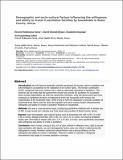| dc.description.abstract | Introduction: the UN General Assembly explicitly recognized the human right to sanitation and acknowledged it as essential to the realization of all human rights. The Kenyan constitution further recognizes that every Kenyan has a right to reasonable standards of sanitation. This however did not imply that the government would fully provide for sanitation for its people. Some of that responsibility lies with the community members, while the government lays more emphasis on sanitation provision at institutional level; the household level remains the responsibility of the household head. While trying to fulfil this obligation to provide sanitation at household level, there could be some demographic and socio-cultural factors influencing the willingness and ability to invest in sanitation facilities by households.
Methods: this was a cross-sectional study, employing quantitative methods with a sample size of 384. It was carried out in Butula and Teso South Sub-counties of Busia County, Kenya.
Results: socio-demographic and cultural factors such as household size (OR=0.95, CI=0.89-0.99, p<0.05), disease prevention (OR=1.96, CI=1.03-3.71, p<0.05), not sharing sanitation facility with chronically ill people (OR=20.4, CI=1.14-363, p<0.05); were significantly associated with willingness and ability to invest in sanitation.
Conclusion: every human, young or old, rich or poor, literate or illiterate, has a right to access basic sanitation with dignity, as such demographic factors were not critical in determining the willingness to invest. However social and cultural factors had a strong influence on the willingness and ability to invest in sanitation. These are useful to consider in designing interventions that target to increase sanitation coverage. | en_US |

